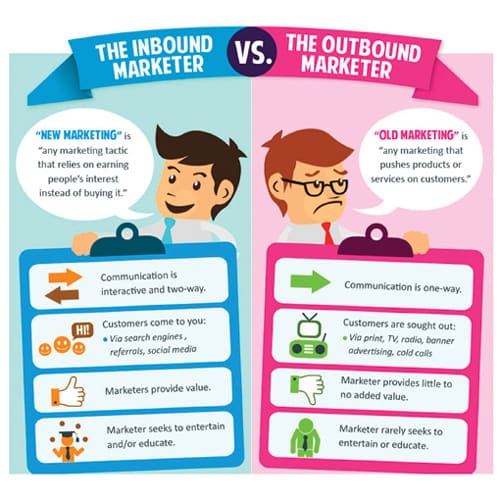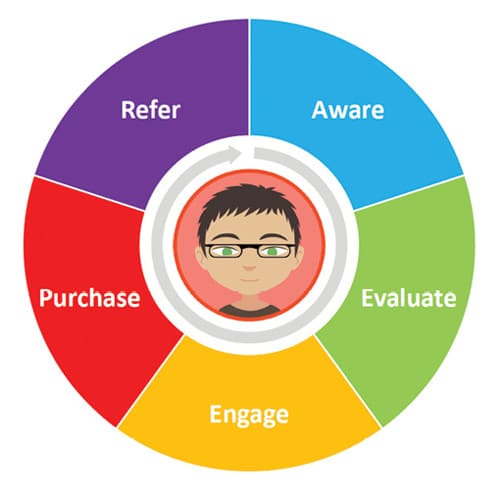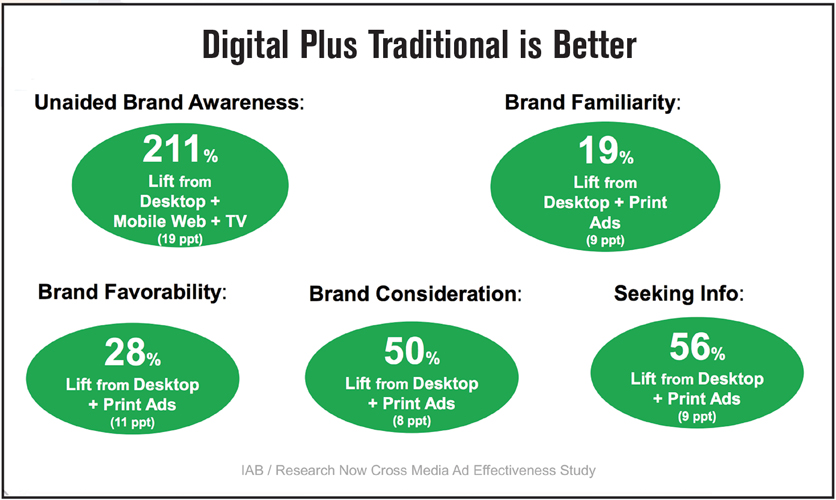The following article is based on Eric Shanfelt's presentation at the 2018 Dealership Minds Summit. To watch the presentation, click here.
“Don’t even bother with marketing if you have a lousy customer experience.”
Before getting into the basics of digital marketing, Eric Shanfelt stresses that no marketing can fix poor customer experience, so that has to be addressed and fixed before spending any money on marketing. The way to start fixing that; look at online reviews, talk to customers and talk to reps.
“You will know if you’ve got a customer service issue,” says Shanfelt. “Fix that first.”
Once that point has been made, Shanfelt begins to boil down what digital marketing is and how it can be used. He breaks down many aspects of digital marketing, including the merits of inbound and outbound marketing, the marketing funnel and the six digital marketing building blocks.
About Eric Shanfelt
Eric Shanfelt, founder and CEO of Local Marketing Institute, recently discussed digital marketing strategies for ag equipment dealers during the 2018 Dealership Minds Summit. Shanfelt has been in the digital marketing world for over 20 years having been the former senior vice president for Penton Media, Interweave and HarperCollins. While Shanfelt comes from outside the farm equipment industry, he brings in some industry knowledge gained through working closely with Lessiter media.
Local Marketing Institute is focused on teaching digital marketing to local businesses and local marketing agencies. The institute offers free, weekly training sessions online. It also offers digital marketing support to businesses through a private Facebook group
For Shanfelt, there are only three reasons for digital marketing:
- Attracting new customers
- Building customer loyalty
- Driving revenue and profits
“You need to ask yourself … is everything that we’re doing tied to one of these three things, and if it’s not, why the heck are we doing it?” says Shanfelt. “Tie it back to one of these three things and then you’ll be able to very quickly identify what should we be doing and what shouldn’t we be doing.”
Inbound vs Outbound Marketing
Shanfelt is a big fan of inbound marketing. Inbound marketing is about making the customer interested enough to ask to do business with the company rather than the company going to the customer. With inbound marketing, it is about having two-way communication. This is about using content marketing to attract the right kinds of people and then moving them through a process until they are turned into a customer.
Even with his love of inbound marketing, Shanfelt points out that inbound marketing tends to claim the credit for all the work that outbound marketing started. Outbound marketing is more of a one-way form of communication. It is marketing more based in pushing the products or services out to the customers. Inbound marketing is eight times more effective if there is already a good outbound program in place to give people brand familiarity, brand awareness, message association and brand favorability. These are brand metrics that most do not enjoy discussing because the ROI on them cannot be measured directly.

How a customer is interacted with and how quickly that interaction occurs determines whether or not the customer stays; this is what inbound marketing is all about. Outbound marketing is needed because without it, these customers may not even be fully aware of the product/service.
“We love the ROI in inbound marketing because we can measure it,” says Shanfelt. “We spend $1,000 on Google advertising and it led to $5,000 worth of sales ... Well, you know what, that $1,000 wouldn’t have been as effective if people had no idea who the heck you were to begin with.”
Shanfelt goes on to propose that the ideal model uses both outbound and inbound marketing. He references a study from Circle Research to back up his proposal. He notes that in this study it was found that around 86% of potential buyers start the buying process with a supplier preference. Around 94% of those people purchase from the supplier. Shanfelt believes that in combining the two, the people captured by the outbound marketing can be nurtured and brought in more though the use of inbound marketing.
The Lifecycle: Customer View

The customer lifecycle is a view of the marketing funnel through the perspective of the customer. The customer can become the greatest advocate for your dealership if they are drawn into doing business with you, but they need to go through these 5 steps.
When it comes to the marketing funnel, Shanfelt finds it best to view it from the perspective of the customer. He calls this the customer lifecycle.
“When they become first aware that we exist, they’re evaluating whether they should do business with us, then they engage with us in one way or another, eventually they become a customer, and then eventually they turn into a referral for us,” says Shanfelt. “They become advocates for us.”
This customer lifecycle has 5 key parts:
- Awareness is first about making sure the customer knows you exist. There are two modes people have when they are online: passive and active. With passive searching, the person is not actively looking for a product or service. The ads they view as they are browsing can have an impact. Those who are actively searching are online to find a service or product.
- Evaluation is the next step. This is the point in which the customer is aware of you and now must decide if they want to do business. The first things a potential customer will do is check the product or service online. They will look at the business listing and the reviews. They’re also going to look at social media and the website.
- Engagement follows after passing the customer’s evaluation. The key tactics of engagement include: calling, getting directions, sending an email, sending messages through social media, signing up for emails and following on social media.
- Purchase is about continuing to collect data after the customer has been gained. With this step, you are tracking the customer’s website activity, events they attend, etc. and then using that for more targeted marketing. The purchase information you gather can then be fed into advertising campaigns.
- Referral is the final step of the lifecycle. In this step, the customer becomes the advocate for the business. This is about encouraging customer reviews and making sure you to manage negative reviews in a timely manner.
6 Digital Marketing Building Blocks

Digital marketing and traditional marketing work well together, and there is strong crossover between demographics seeing both forms. Eric Shanfelt stresses you need to reach people in both modes. A study by the Internet Advertising Bureau in conjunction with Circle Research and Price Waterhouse Coopers found when digital and print are combined, brand familiarity received a 19% lift over just digital alone or print alone. People seeking information saw a 56% lift when a company ran print and digital vs. either alone.
For Shanfelt, there are six major things to work on with digital marketing: local search, the website, reputation, social media, email and advertising. These are what he refers to as the six digital marketing building blocks.
1 When doing a search, there are three types of search results; paid ads, local business listings and website search results. Paid ads are ones in which the space needs to be purchased by the business. With local search engines, the number one factor is proximity to the person searching. When the customer searches for a product or service, the search engine uses the person’s location as one way of determining which results pop up first.
2 The second part to the digital marketing building blocks involves the website. The website needs to be mobile, fast and secure. It also needs to be designed for humans first rather than for Google. This means making sure it is designed to show the company, what the company does and how to connect with the company.
3 For reputation, Shanfelt touched on the importance of this numerous times through his presentation. This is about doing things like responding to reviews, both positive and negative ones, and doing so in a timely manner. He also notes that there are reputation management sites that can be used as well.
4 With social media, Facebook and Google My Business are the most important platforms. Post regularly on both platforms, making sure to have a call to action and to post interesting things.
5 Email should be a priority. Emails should go out regularly, preferably weekly, but should also be something that the customer actually wants to see. The content should be relevant and timely but also personalized when it can be.
6 The final of the digital marketing building blocks is advertising. At the bare minimum, businesses should be spending at least $5 a day on geotargeted Facebook ads. This means figuring out the geographic radius of customers and targeting them with ads. These ads on Facebook can also go onto Instagram. Another $5 a day should be spent on geotargeted Google ads on the search network.
With Shanfelt, every aspect of marketing comes back to the customer and trying to see it from their perspective. “I always recommend that everything you do - emails you put out, social media posts you put out, your website, your Google My Business listing - whatever it may happen to be, step away, pretend you knew nothing about your business,” says Shanfelt. “Would it make sense to you? Would it make you want to do business with you? Would it entice you to call up that company and start to work with them? Those are the things you’ve got to ask yourself.”
Shanfelt concludes stating that if you are going to do anything, make sure it is responding to customers quickly. Responding to customers like that will do more for business than anything else, including digital marketing. He also says to make sure to spend the $5 on the Facebook and Google ads.
“If you do nothing more than those things you’re going to knock it out of the park,” he says. “Everything else … is just icing on the cake and takes you to the next step.”
Awareness is first about making sure the customer knows you exist. There are two modes people have when they are online: passive and active. With passive searching, the person is not actively looking for a product or service. The ads they view as they are browsing can have an impact. Those who are actively searching are online to find a service or product.
Evaluation is the next step. This is the point in which the customer is aware of you and now must decide if they want to do business. The first things a potential customer will do is check the product or service online. They will look at the business listing and the reviews. They’re also going to look at social media and the website.
Engagement follows after passing the customer’s evaluation. The key tactics of engagement include: calling, getting directions, sending an email, sending messages through social media, signing up for emails and following on social media.
Purchase is about continuing to collect data after the customer has been gained. With this step, you are tracking the customer’s website activity, events they attend, etc. and then using that for more targeted marketing. The purchase information you gather can then be fed into advertising campaigns.
Referral is the final step of the lifecycle. In this step, the customer becomes the advocate for the business. This is about encouraging customer reviews and making sure you to manage negative reviews in a timely manner.
Titan Machinery’s Jeff Bowman: 7 Key Changes to Transform Dealership Marketing
The Importance of Improving Your Marketing ROI & How to Do It
Target Customer Interactions Using Content Marketing
How YouTube Fits in the Marketing Mix & Making It More Effective
Getting Results with Do-It-Yourself Marketing
Leveraging CRM for Farm Equipment Leads and Sales
How to effectively use digital marketing for ag equipment dealers
Good Data Takes Digital Marketing Further for Farm Equipment Dealerships






